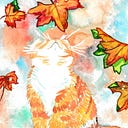Moose, As A Sacred Animal

(In Finnish Mythology)
Bear Clan and a Moose Clan
There are many archaeological finds made from different parts of Finland which suggest that there has been two major clans, the bear clan and the moose clan. It is also possible that under these two major clans there have been smaller clans (clan of the swan, clan of the lynx..). When the area of Finland was first populated after the ice age 10 000 years ago first tribes who arrived were small hunter-collecter communities who had totemic belief systems. Moose and the bear were important animals. From Finnish cave paintings, one can find moose, deer and snakes but not bears. Since the name of the bear was a tabu, perhaps painting the image of the god was tabu as well.

Cosmological Moose
In Siberian and Sami myths and legends a great moose runs in the skies and it holds the sun in its antlers. It is chased by a giant hunter who skis behind it. Hunter chases the moose, again and again, each day. In the nighttime, the moose swims in the river of death. When the hunter shoots the moose sun goes out and the world comes to an end.
https://www.youtube.com/watch?v=-OI--nr4ezw&t=1s
This myth is common among all native groups in the northern hemisphere. In some myths, moose is chased by a bear or one hunter or two hunter brothers. In the mythology of the Mansi people, god created a moose who had six legs. It was way too fast for a man to hunt so the man asked the spirit of the forest to help him. After a long time of skiing man finally caught the moose and cut two of its legs off. Now the moose wasn´t too fast for man. Moose became the constellation of Ursa Major and the Milky Way was given for the forest spirit as a thank you- gift.

Hiidenhirvi
In the Finnish ethology, Kalevala the hunter Lemminkäinen wanted the beautiful woman of the north for himself but Louhi, the ruler of the north was suspicious about Lemminkäinen and ordered different tasks for him to perform. The first task was to catch Hiidenhirvi. It was a giant moose created by the trolls in Hiitola but it had gotten loose and it destroyed all people and buildings where ever it went. Lemminkäinen tried to catch the moose but he failed the first time. On the second time, he asked the creatures of the forest to help him and together they managed to catch the moose. In Kalevala, Hiidenhirvi was created by the trolls but according to other sources, it has cosmological origins and was born in the stars.

In 98 AC Roman historian Tacitus mentions strange beings in his book Germania. He talks about fenns which was an old name given for the Saami people. Tacitus mentions two tribes living in the land of the Fenns. They are called helluusi and oksi. They have human faces and feet and bodies of wild animals. Finnish folklorists Tuomo Pekkanen and Matti Kuusi have researched texts of Tacitus and Finnish folktales. According to them, there was two tribes in ancient Finland, the tribe of the bear and the tribe of the moose. This would explain the great number of stone sculptures portraying bear and moose heads that have been found from different archaeological excavations from Finland. They suggest that the people who Tacitus describes were shamans performing a ritual dressed up as bears and moose, their totem animals.
Moose were nearly killed to extinction in Finland at the end of the 19th century but nowadays thanks to conservation there is about 80 000–90 000 moose roaming in Finnish forests.
Subscribe to my channel: https://www.youtube.com/user/fairychamber
If you enjoy reading my content, consider subscribing to my feed. Also, if you are not a Medium member and you would like to gain unlimited access to the platform, consider using my referral link right here to sign up. It’s $5 a month and you get unlimited access to my articles and many others like mine. Thanks.
